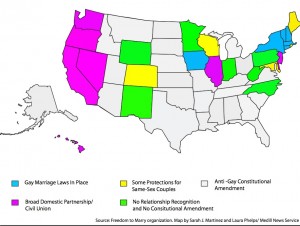WASHINGTON – Vermont’s percentage of same-sex households ranks among the highest in the country, following a pattern for states that have legalized gay marriage, according to new Census Bureau data released Tuesday.
 Vermont had 2,143 same-sex households according to revised data, or 0.84 percent of the state’s total households.
Vermont had 2,143 same-sex households according to revised data, or 0.84 percent of the state’s total households.
Nationally, same-sex couple households increased from 0.56 percent to 0.77 percent of total households from 2000 to 2010.
When the data were reported in 2010, five states and the District of Columbia handed out marriage licenses to same-sex partners. The states were Vermont, Connecticut, Iowa, Massachusetts and New Hampshire. Also in 2010, three states – Rhode Island, New York and Maryland – recognized same-sex marriage from states that had legalized it.
This latest census data showed Vermont trailed only the District of Columbia with the highest percentage of same-sex households. Among those in the next tier, with percentages from 0.80 percent and lower, were Maine, New Hampshire, Rhode Island, Massachusetts, New York, Connecticut, Maryland and California.
“It shows gay people are in every part of the country: in every county, in every community,” said Evan Wolfson, founder and president of Freedom to Marry.
Of the 2,143 Vermont same-sex households, one-third were male and two-thirds were female.
Of the 718 male households, two-thirds reported being unmarried, and only 3 percent of those reported having a child. One-third of men in same-sex households reported being married; of those, 16 percent have at least one child, according to the data.
Among the female households, 65 percent were unmarried; 13 percent of those had a child under 18 years old. Nearly 30 percent of married female households had children.
Unlike Vermont, the ratio for male and female same-sex households is nearly even on a national level, the data showed.
After speaking with lesbian, gay, bisexual and transgender, or LGBT, groups and consultants, the Census Bureau decided not to break down the data further than the state level for fear of undermining individuals’ privacy in small communities, census official Martin O’Connell said Tuesday.
While Vermont’s married gay couples are recognized legally within the state, Wolfson said they are still discriminated against because their relationships are not recognized at the federal level.
Sheryl Rapée-Adams, chair of the organization’s volunteer task force in Vermont, the Vermont Freedom To Marry, agreed that the couples her volunteer group represents have a hard time in terms of equal legal status. This difficulty can occur both in and outside the state of Vermont.
“In Vermont, even though a same-sex couple has marriage equality under the state, when they step outside Vermont’s borders, legally, they might be strangers to each other,” she said. One example: A couple travels to visit family in a state where gay marriage is not legal. During the visit, one spouse becomes ill and is hospitalized. The healthy spouse has no legal rights, in that state, to visit the ill partner in the hospital and, in terms of medical care and treatment authorizations, the two are not legally recognized as family members.
Same-sex couples also live with this sort of uneven equality because of federal restrictions. In Vermont, for example, couples can file state taxes jointly, but they must file federal taxes separately because the federal government does not recognize gay marriage.
Indeed, the Congress approved the Defense of Marriage Act, stating that marriage is limited to a union between a man and a woman. DOMA, as it is known, was signed into law by President Bill Clinton on September 21, 1996. For federal employees, Rapée-Adams said, this declaration means that federal health care benefits and other forms of benefit coverage cannot be extended to a same-sex spouse, even if the couple is legally married.
In addition to unveiling the latest state-by-state numbers, census officials released a new set of data for same-sex households that more accurately captures the number of households in each state, O’Connell said.
Census officials realized in late 2009 that there were problems with the data from some states because people had mischaracterized themselves due to confusion with the forms.
Previous data and the American Community Survey (completed more often but with less accuracy) capture major trends in growth, O’Connell said, but misreported raw data at a state level in some cases.
Despite that glitch, Vermont’s data remained consistent with previous census reports. Both Vermont and the District of Columbia’s data changed the least. Original 2010 census data reported 2,798 same-sex households in Vermont, or 1.1 percent, but revised data reported 2,143 households at 0.84 percent. The District of Columbia ranked highest in the country with 1.81 percent of households.
O’Connell said respondents may have been more comfortable declaring themselves to be in same-sex partnerships if they lived in states that legally recognized their marriages and partnerships.
People from states that do not recognize same-sex partnerships may have declared themselves spouses after living together or engaging in a domestic partnership or civil union, he said.
The census does not collect marital history, so statisticians were unable to track when the marriages occurred or whether couples were married in Vermont or moved from another state.
